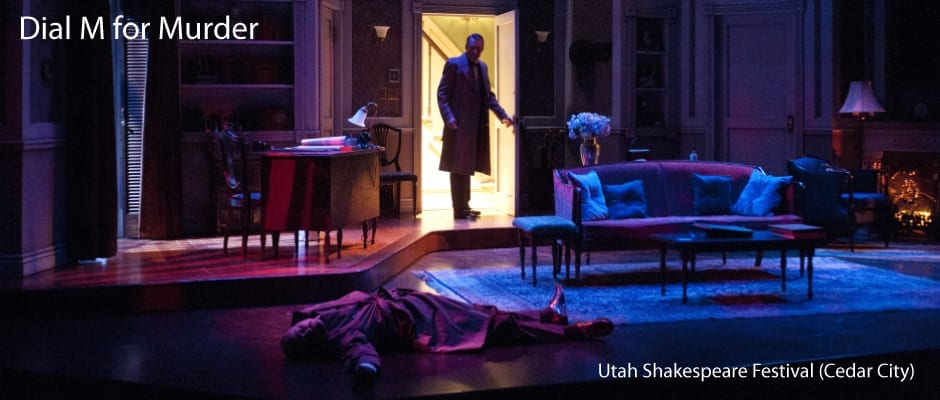
CEDAR CITY — Last year, the Utah Shakespeare Festival produced The 39 Steps, a stage adaptation of a 1935 Alfred Hitchcock film. This year the Festival has decided to produce another classic of suspense, Dial M for Murder, which Hitchcock turned into a renown 1954 film staring Grace Kelly. Dial M for Murder is a play in which cuckolded husband Tony Wendice carefully plans the perfect murder with his wife Margot as the victim. He hires a small-time conman acquaintance named Captain Lesgate to execute the plan.
The classic script, written by Frederick Knott, has three acts and two intermissions. The first act is extremely slow and talky and consists almost exclusively of exposition. It’s all necessary for the next two acts to make sense, but slogging through it can be rather tedious. The pacing picks up once the murder is to occur and the suspense is almost palpable. Brian Vaughn, the director of the production, effectively guides the audience through all the twists and turns of the plot and during the second and third acts Vaughn raises the tension consistently until the very end.
Vaughn had a great deal of help in establishing a creepy atmosphere from his virtuosic technical designers, especially lighting designer Donna Ruzika. Ruzika introduced moments in lighting that emphasized the sinister nature of Tony’s plot, such as when Tony first calls Lesgate or the moments just before the murder. Indeed, I thought that much of the suspenseful mood that permeated the production was a result of Ruzika’s lighting. The sound design (from Barry G. Funderburg) also increased the tension as the audience heard footsteps, glass breaking, or doorknobs turning off stage. Funderburg’s music was also effective in conveying the time period of the play—1952—and for serving as an underscore to the suspense on stage. Despite Funderburg’s valuable contributions to the play, Vaughn was not afraid to use silence in the play to convey emotion, unease, or meaning to the audience. I found it refreshing that Vaughn could trust his cast to communicate to the audience without speaking a word.
The clear star of the production is David Ivers, who plays the plotting Tony Wendice. Ivers’s role is the only one in the script that has multiple levels of meaning and a great deal of emotional nuance. Ivers probed the deep psychology of Tony and was impressive as he seemed to play the innocent, desperate husband to the police while privately trying to thwart their investigation. I think Ivers had his most interesting scene when his character recalls the moment when he discovered his wife’s affair. I found Ivers’s performance in this moment exceptional because he didn’t seem to just be recalling the affair. Rather, he was reliving both the events and all the pain that he suffered through. The gripping performance in this emotionally turbulent section of the script made Tony’s plot to murder his wife seem like an appropriate consequence of his pain. I was also impressed how Ivers adopted a completely different set of mannerisms from what I’ve seen him perform in other plays or in real life when I interviewed him last summer. I truly think that there is very little of the real David Ivers in his performance of Tony Wendice, which is a strong testament to his talent as an actor.
Melinda Pfundstein probably hit the entire range of human emotion during the performance as Margot. She was giddy and nostalgic when she met up with her former lover Max Halliday (John Taylor Phillips), and she was distraught and panicky as her husband’s diabolical plot unfolded. Pfundstein’s performance during the murder scene, though, had me on the edge of my seat. I compliment her, Todd Denning (who played the hired murderer), and Vaughn for creating a gripping scene. It’s so easy for stage violence to seem rehearsed and hokey, but Pfundstein’s reaction and the desperation with which she fought her attacker gave me an adrenaline rush. It will truly be one of those theatrical moments that I remember for years.
I appreciated the other actors’ performances, although Knott did not give them as much psychological depth as he gave to the character of Tony and—to a lesser extent—Margot. Jonathan Gillard Daly played the Inspector Hubbard, whose job it is to unravel the mystery behind the murder in the Wendices’ apartment. Basically, Daly’s role serves to guide the audience through the plot in the second and third acts. While this could be a very mechanical role, Hubbard gave added personality to the character that did not detract from the intricate story. Phillips’s performance as Max Halliday was serviceable, but not noteworthy. I don’t think that this is any fault of Phillips. His character doesn’t have much to do except set up the exposition and then to be someone for Hubbard to talk to in the third act.
If you can get through all the exposition of the first act, then Dial M for Murder is a suspenseful production and a perfect event for your Halloween season calendar. It’s not my favorite show that I’ve seen at the Utah Shakespeare Festival, but it certainly meets the Festival’s high standards of quality and artistic excellence.
[box type=”shadow”]The Utah Shakespeare Festival production of Dial M for Murder plays on the campus of Southern Utah University at the Randall L. Jones Theater on selected days at 2 PM or 7:30 PM through October 22 (except Sundays). Tickets are $30-58. For more information, visit www.bard.org.[/box]

